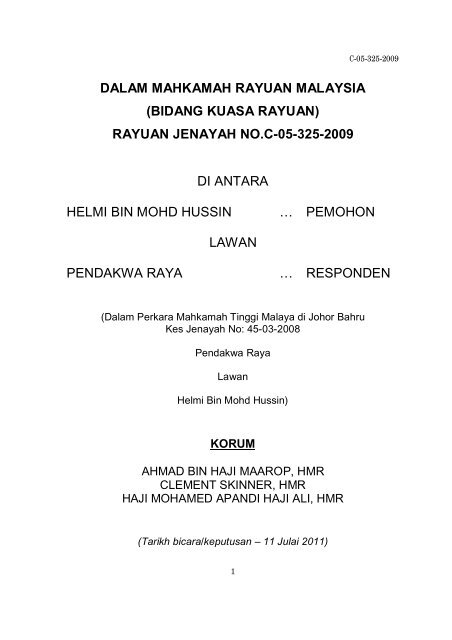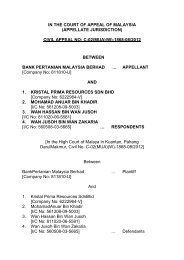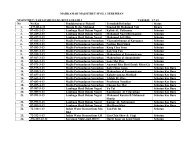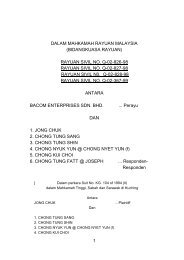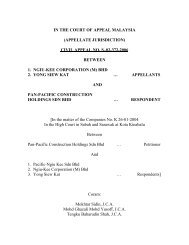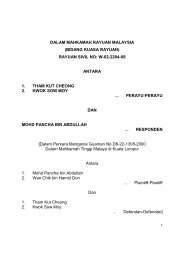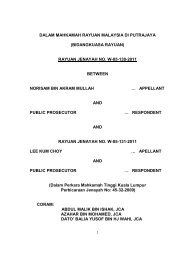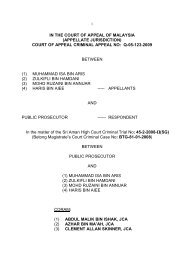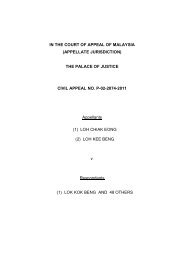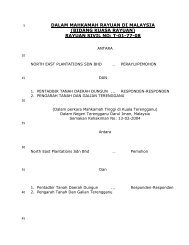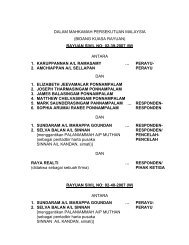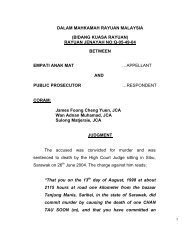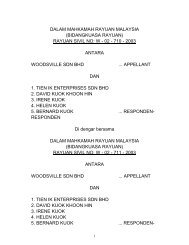rayuan jenayah no.c-05-325-2009 di antara helmi bin mohd hussin
rayuan jenayah no.c-05-325-2009 di antara helmi bin mohd hussin
rayuan jenayah no.c-05-325-2009 di antara helmi bin mohd hussin
Create successful ePaper yourself
Turn your PDF publications into a flip-book with our unique Google optimized e-Paper software.
DALAM MAHKAMAH RAYUAN MALAYSIA<br />
(BIDANG KUASA RAYUAN)<br />
RAYUAN JENAYAH NO.C-<strong>05</strong>-<strong>325</strong>-<strong>2009</strong><br />
DI ANTARA<br />
1<br />
C-<strong>05</strong>-<strong>325</strong>-<strong>2009</strong><br />
HELMI BIN MOHD HUSSIN … PEMOHON<br />
LAWAN<br />
PENDAKWA RAYA … RESPONDEN<br />
(Dalam Perkara Mahkamah Tinggi Malaya <strong>di</strong> Johor Bahru<br />
Kes Jenayah No: 45-03-2008<br />
Pendakwa Raya<br />
Lawan<br />
Helmi Bin Mohd Hussin)<br />
KORUM<br />
AHMAD BIN HAJI MAAROP, HMR<br />
CLEMENT SKINNER, HMR<br />
HAJI MOHAMED APANDI HAJI ALI, HMR<br />
(Tarikh bicara/keputusan – 11 Julai 2011)
GROUNDS OF JUDGMENT<br />
2<br />
C-<strong>05</strong>-<strong>325</strong>-<strong>2009</strong><br />
[1] Helmi Bin Mohd Hussin (“the appellant”) was convicted by the<br />
Temerloh High Court of trafficking in 936.47 grams of cannabis, an<br />
offence punishable under section 39 B(2) of the Dangerous Drugs Act<br />
1952 (“DDA”). We heard his appeal against such conviction and<br />
sentence and <strong>di</strong>smissed it. This is our reasons for doing so.<br />
Brief facts<br />
[2] The facts of this case are dealt with fully in the judgment of the<br />
High Court. It will only be necessary to set out briefly here those parts of<br />
the facts that are relevant to this appeal.<br />
[3] Insp. Asfanizairil Shafry (SP3) led a raid on the house stated in the<br />
charge at 9.15 p.m. He k<strong>no</strong>cked on the main door which was opened by<br />
a Malay lady. In the living room were a Malay man and 2 children. The<br />
man was the appellant’s brother and the Malay lady was his sister-in-<br />
law.<br />
[4] On searching the house SP3 <strong>no</strong>ticed a locked room in the middle<br />
portion of the house. SP3 k<strong>no</strong>cked on the door of that room. About 30<br />
seconds later the door was opened by a male Malay, subsequently<br />
identified as the appellant. On gaining entry into the room, SP3 testified<br />
that he “<strong>no</strong>ticed just near the entrance of the door a compact slab of<br />
dried leaves, 3 slices of slab of dried leaves as well as powder of dried<br />
leaves, a weighing scale, a blade saw placed on newspaper on the
3<br />
C-<strong>05</strong>-<strong>325</strong>-<strong>2009</strong><br />
floor”. SP3 left everything as they were in the room and imme<strong>di</strong>ately<br />
arranged for a police photographer (SP2) from Temerloh Police Station<br />
to take photographs of what was found in the room. After that all the<br />
items were seized. The dried leaves were sent to the Chemistry<br />
Department for analysis. They were confirmed to be cannabis weighing<br />
936.47 grams.<br />
The appellant raised only the 2 following grounds in this appeal.<br />
1. That the learned trial judge mis<strong>di</strong>rected himself when his<br />
Lordship in his written grounds invoked the trafficking<br />
presumption under section 37 (da) of the DDA when he <strong>di</strong>d<br />
<strong>no</strong>t do so at the end of prosecution’s case.<br />
[5] At the close of the prosecution’s case the learned Judge gave a<br />
short ruling that the prosecution had established a prima facie case<br />
against the appellant. He said (at pg 86 Record of Appeal):<br />
“Secara rumusan kesemua rangkaian keterangan <strong>di</strong> dalam kes ini, saya<br />
berpendapat bahawa bukan sahaja satu anggapan tapi telah timbul satu<br />
inference yang kukuh bahawa tertuduh telah memiliki dadah tersebut<br />
untuk tujuan pengedaran. Saya berpuas hati bahawa pendakwa dalam<br />
kes ini telah berjaya membuktikan kes prima facie terhadap tertuduh dan<br />
saya arahkan tertuduh membela <strong>di</strong>ri <strong>di</strong> atas tuduhan yang <strong>di</strong>hadapi.”<br />
[6] The appellant took two points against this ruling:
4<br />
C-<strong>05</strong>-<strong>325</strong>-<strong>2009</strong><br />
(a) first, it was erroneous for the learned Judge to rule that a case of<br />
trafficking had been made out based on an inference of<br />
possession and from that inference the learned Judge made an<br />
inference of trafficking.<br />
In short the appellant complains that the learned Judge had made<br />
“an inference upon an inference” which, accor<strong>di</strong>ng to the appellant,<br />
was entirely wrong. Accor<strong>di</strong>ng to the appellant, with regard to the<br />
element of possession, it was open to the learned trial judge to either<br />
make an affirmative fin<strong>di</strong>ng of possession (as stated by the Federal<br />
Court in Muhammed Bin Hassan [1998] 2 MLJ 273 at pg 289) or rely<br />
on “deemed possession” under s 37(d) of the DDA. Accor<strong>di</strong>ng to<br />
counsel, the learned judge <strong>di</strong>d <strong>no</strong>t make an affirmative fin<strong>di</strong>ng that the<br />
appellant was in possession of the offen<strong>di</strong>ng drugs at the end of the<br />
prosecution’s case, but instead made an “”inference on an inference”<br />
which , accor<strong>di</strong>ng to learned counsel, is unk<strong>no</strong>wn in law and on this<br />
ground alone the conviction can<strong>no</strong>t stand.<br />
We find <strong>no</strong> merit in this contention. The ruling of the learned<br />
Judge was but his brief reasons for calling the appellant to enter on<br />
his defence. When the learned Judge came to write his judgment, he<br />
gave full reasons for his ruling on a prima facie case. It is clear to us<br />
from his judgment that the learned Judge <strong>di</strong>d <strong>no</strong>t make an inference<br />
upon an inference as alleged. From a rea<strong>di</strong>ng of his judgment it is<br />
evident that the learned Judge was fully aware that in law for a<br />
person to be in “possession” of a thing, there is a physical element<br />
i.e. physical possession of the thing possessed, and a mental
5<br />
C-<strong>05</strong>-<strong>325</strong>-<strong>2009</strong><br />
element i.e. that the person k<strong>no</strong>ws what he is in possession of. It<br />
was to the mental element of possession that the learned Judge was<br />
referring to when he said possession can be inferred. Thus at pg 18<br />
of the Record of Appeal the learned Judge said:<br />
“In this case one fact which I relied on to draw an inference of possession<br />
is the place where the drugs were found that is right at the entrance of the<br />
room and in the sight of everyone present in the room. Therefore<br />
k<strong>no</strong>wledge could be inferred quite rea<strong>di</strong>ly” (our emphasis).<br />
As far as the physical element is concerned, the learned<br />
Judge said at page 19 of the Record of Appeal that the presence<br />
of the weighing scale, the saw and the sliced pieces of drugs show<br />
that the appellant was in the midst of working on the drugs. The<br />
learned Judge said it can be strongly inferred from those facts that<br />
the appellant had full control and custody of the drugs. We can<strong>no</strong>t<br />
find any fault in what the learned Judge said about the inference to<br />
be drawn from the circumstances surroun<strong>di</strong>ng the fin<strong>di</strong>ng of the<br />
offen<strong>di</strong>ng drugs on the day in question. To our minds when the<br />
learned judge said it can be inferred from the circumstances just<br />
described that the appellant was <strong>no</strong>t only in full control and<br />
custody of the drugs but it could be rea<strong>di</strong>ly inferred that he knew<br />
what he was in possession of i.e. the offen<strong>di</strong>ng drugs, the learned<br />
Judge was in fact making an affirmative fin<strong>di</strong>ng of possession.<br />
As far as the element of trafficking is concerned, the learned<br />
Judge came to a fin<strong>di</strong>ng of fact at page 23 of the Record of Appeal
6<br />
C-<strong>05</strong>-<strong>325</strong>-<strong>2009</strong><br />
that since the appellant was found in possession of drugs which<br />
weighed 936.47 grams, the presumption under s 37 (da) of the DDA<br />
was triggered. Clearly he had <strong>no</strong>t made any inference or inference<br />
on an inference to find the appellant was trafficking in drugs. He<br />
applied the statutory presumption against the appellant after he had<br />
affirmatively found that the appellant was in possession of the drugs<br />
and the weight of the cannabis was more than 200 grams. For this<br />
reason we do <strong>no</strong>t think the learned Judge had run foul of what the<br />
Federal Court said in Muhammed Bin Hassan (supra) about the need<br />
of a trial judge to make an affirmative fin<strong>di</strong>ng of possession before<br />
invoking the presumption of trafficking in the said drug under s 37(da)<br />
of the DDA.<br />
(b) With regard to the second point taken, the appellant complained<br />
that it was erroneous for the learned Judge in his written grounds<br />
at page 23 of the Record of Appeal to find that the appellant made<br />
<strong>no</strong> attempt to rebut the s 37 (da) presumption when the learned<br />
Judge never invoked the said presumption at the end of the case<br />
for the prosecution.<br />
The appellant contends that his fair trial was preju<strong>di</strong>ced and<br />
compromised when the learned Judge <strong>di</strong>d <strong>no</strong>t in<strong>di</strong>cate in his ruling<br />
that he was relying on the presumption of trafficking in s 37(da) to<br />
find a prima facie had been made out. In the circumstances, the<br />
appellant says he was under <strong>no</strong> obligation to rebut the<br />
presumption of trafficking in his defence. To do so was<br />
procedurally and substantially unfair to him.
7<br />
C-<strong>05</strong>-<strong>325</strong>-<strong>2009</strong><br />
[7] We do <strong>no</strong>t agree. Under s 180 Criminal Procedure Code (“CPC”),<br />
at the close of the prosecution case, on the learned Judge’s fin<strong>di</strong>ng that<br />
a prima facie case had been made out against the appellant, he need<br />
only to pro<strong>no</strong>unce so and call the appellant to enter on his defence. The<br />
provisions of law do <strong>no</strong>t require the learned Judge to give reasons at the<br />
time he pro<strong>no</strong>unced his fin<strong>di</strong>ng of a prima facie case.<br />
[8] In PP v Mohd Radzi <strong>bin</strong> Abu Bakar [20<strong>05</strong>] 6 MLJ 393 one of the<br />
questions raised before before the Federal Court was whether, prior to<br />
the amendment of ss 173(f) and 180 CPC, it was incumbent for a court<br />
to make a fin<strong>di</strong>ng at the close of the prosecution case that the<br />
prosecution had proved its case beyond reasonable doubt. The Federal<br />
Court held that it was <strong>no</strong>t necessary to do so and that the case of<br />
Arulpragasam a/l Sandaraju v PP [1997] 1 MLJ 1 was <strong>no</strong>t authority for<br />
that proposition. The apex court went on to say that the failure by the<br />
court either to make or record such a fin<strong>di</strong>ng does <strong>no</strong>t occasion a<br />
miscarriage of justice. It is sufficient for the ju<strong>di</strong>cial arbiter – be he a<br />
judge or magistrate – to give his reason in his written grounds of<br />
judgment for requiring an accused to make his defence. What this<br />
meant was that in a case such as this, involving a charge under s 39B(2)<br />
DDA, the trial court need <strong>no</strong>t, when calling for the defence, in<strong>di</strong>cate<br />
whether it had applied the statutory presumption under s 37(da) DDA,<br />
the court may do so in its written grounds of judgment. After the<br />
amendment to ss 173(f) and 180 of the CPC, the Federal Court said the<br />
position <strong>di</strong>d <strong>no</strong>t change but the statutory test had been altered – all that<br />
was required was for the subor<strong>di</strong>nate court and High Court to be<br />
satisfied that a prima facie case had been made out at the close of the
8<br />
C-<strong>05</strong>-<strong>325</strong>-<strong>2009</strong><br />
prosecution case, but in reaching that decision, the court had to<br />
undertake a maximum evaluation of the prosecution evidence.<br />
[9] Reverting to the facts of this case, if the learned Judge had<br />
chosen that course which was open to him to take and had merely<br />
an<strong>no</strong>unced that he was satisfied that a prima facie case had been out at<br />
the close of the prosecution case, his ruling would <strong>no</strong>t be open to the<br />
criticism that he had <strong>no</strong>t in<strong>di</strong>cated to the appellant that he had invoked<br />
the statutory presumption of trafficking against him. If that be the case,<br />
we do <strong>no</strong>t see on what basis it can be said that the appellant has been<br />
preju<strong>di</strong>ced by the ruling made by the learned Judge in this case.<br />
2. The second ground of appeal was that: The failure of the<br />
prosecution to call or at least offer the other two adult occupants in<br />
the house has compromised the case for the prosecution.<br />
[10] The complaint here is that the appellant’s brother Shaiful Bahari<br />
Bin Mohd Hussein and his wife who were in the house when the police<br />
recovered the drugs, were <strong>no</strong>t called as prosecution witnesses <strong>no</strong>r were<br />
they offered to the defence. The appellant says his brother Shaiful<br />
Bahari was particularly important as it was established in evidence from<br />
Ahmad Fahmi Bin Abdullah (SP6) the owner of the house, that the<br />
house was rented out to his brother Shaiful Bahari. Accor<strong>di</strong>ngly, the<br />
appellant contends that Shaiful Bahari was deemed, under s 37(b) DDA,<br />
to be the occupier of the premises in which the drugs were found, until<br />
the contrary is proved. Further Shaiful Bahari was a suspect in the case<br />
as he was arrested together with the appellant, had his statement taken
9<br />
C-<strong>05</strong>-<strong>325</strong>-<strong>2009</strong><br />
and he was charged. The appellant submitted that without Shaiful<br />
Bahari or his wife being called, there was <strong>no</strong> evidence that the room<br />
where the drugs were found was occupied by the appellant and that<br />
others had <strong>no</strong> access to the room. In fact it was the appellant’s defence<br />
that the drugs belonged to one Mahasan and by calling Shaiful Bahari<br />
and his wife it could be established whether Mahasan had access to the<br />
room. The appellant said the failure to call or offer these important<br />
witnesses brought about the following consequences:<br />
(i) the appellant is entitled to an acquittal as Shaiful was<br />
essential to the unfol<strong>di</strong>ng of the prosecution’s narrative;<br />
(ii) that possession has <strong>no</strong>t been proved;<br />
(iii) that there was a gap in the prosecution case and section 114<br />
(g) of the Evidence Act can be invoked.<br />
[11] We do <strong>no</strong>t agree. We find <strong>no</strong> merit in the above contentions.<br />
[12] Even though Shaiful Bahari may have been the tenant of the<br />
house and therefore deemed to be in occupation of it, the court has a<br />
duty to decide a case on its own particular facts. The evidence shows<br />
that the drugs were <strong>no</strong>t recovered from a common area or general area<br />
of the house, but from a particular room which was locked, the<br />
imme<strong>di</strong>ate occupant of which room was the appellant. It was he who<br />
opened the door of the room and <strong>no</strong> one else was in that room where<br />
the drugs were found.<br />
[13] We do <strong>no</strong>t accept the appellant’s contention that Shaiful Bahari<br />
and his wife were important witnesses for the unfol<strong>di</strong>ng of the
10<br />
C-<strong>05</strong>-<strong>325</strong>-<strong>2009</strong><br />
prosecution’s narrative by reason of the fact that it was they who could<br />
have given evidence whether the room in which the drugs were found<br />
was occupied by the appellant and that <strong>no</strong> others had access to that<br />
room. With respect, the critical question before the learned Judge was<br />
<strong>no</strong>t whether the appellant occupied the room in which the drugs were<br />
found. The critical question was whether the appellant was in<br />
“possession” of the drugs found in the room, i.e. he had physical<br />
possession of the drugs and knew what he was possessing. In our<br />
judgment there was overw<strong>helmi</strong>ng evidence to prove that the appellant<br />
was in possession of the drugs. As the learned Judge found, with which<br />
fin<strong>di</strong>ng we agree, the drugs on the floor of the locked room, with the<br />
weighing scales, blade saw and 3 sliced pieces of the drugs shows that<br />
the appellant was working on the drugs. He had “possession” of the<br />
drugs in every sense of that word as understood in the law. From the<br />
evidence just described, it is reasonable to conclude, using the words in<br />
the case of Chan Pean Leon v PP [1956] MLJ 237 that the appellant<br />
was in possession of the drugs at the material time as he was “so<br />
situated to it (i.e. the drugs) that he had power to deal with it as owner to<br />
the exclusion of all others”.<br />
[14] We accor<strong>di</strong>ngly find that the <strong>no</strong>n-calling of Shaiful Bahari and his<br />
wife <strong>di</strong>d <strong>no</strong>t cause a gap in the prosecution’s case or have the<br />
consequences alleged by the appellant. We find the omission to do so<br />
<strong>di</strong>d <strong>no</strong>t occasion a failure of justice as there was other cre<strong>di</strong>ble evidence<br />
before the court to prove that the appellant was found in possession of<br />
the offen<strong>di</strong>ng drugs.
11<br />
C-<strong>05</strong>-<strong>325</strong>-<strong>2009</strong><br />
[15] It was for all the above reasons that we <strong>di</strong>smissed the appellant’s<br />
appeal and affirmed the conviction and sentence imposed by the High<br />
Court.<br />
Dated: 8 th March 2012<br />
COUNSEL<br />
DATUK CLEMENT SKINNER<br />
Judge<br />
Court of Appeal<br />
Malaysia<br />
For the Appellant: Hisyam Teh Poh Teik<br />
Muhammad Hasif Hassan with him<br />
Messrs Hasif & Co<br />
Advocates & Solicitors<br />
Kota Bharu, KELANTAN<br />
For the Respondent: Tengku Amir Zaki Bin Tengku Hj Abdul<br />
Rahman, DPP<br />
Attorney-General’s Chambers<br />
PUTRAJAYA


